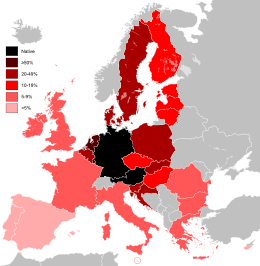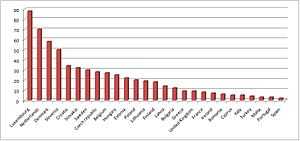German as a foreign language


The German language is one of the most widely spoken of the languages of Europe. German is one of the official languages of the European Union, and one of the three working languages of the European Commission, along with English and French.
In the Early Modern period, German was the lingua franca of Central, Eastern and Northern Europe (Hanseatic League).[1] Today, it is widely spoken as a second language in the European Union; according to a 2005 study, 12% of EU population speaks German as a second language (second to English at 34%, and just alongside French at 11%).[2] 32% percent of citizens of the EU-15 countries say they can converse in German (either as a mother tongue or as a second/foreign language).[3]
German competence in countries where it is not an official language is highest in the countries immediately adjacent to Germany and Austria (Netherlands, Denmark, Luxembourg and Slovenia, to a lesser extent Czech Republic, Slovakia, Hungary, Poland, Sweden, Belgium) and in the Balkans (Bosnia and Herzegovina and Croatia).
German studying as a foreign language has been declining since at least 2000 : German learners went from 20,167,616 in 2000 to 16,718,701 in 2005 to 14,042,789 in 2010.[4][5][6]
German as a foreign language is promoted by the Goethe Institute, which works to promote German language and culture worldwide. In association with the Goethe Institute, the German foreign broadcasting service, Deutsche Welle offers a range of online German courses and radio broadcasts produced with non-native German speakers in mind.
See also
References
- ↑ von Polenz, Peter (1999). "6.5. Inter- und übernationale Beziehungen". Deutsche Sprachgeschichte vom Spätmittelalter bis zur Gegenwart. de Gruyter Studienbuch (in German). Band III: 19. und 20. Jahrhundert. Berlin; New York: de Gruyter. pp. 192–194, 196. ISBN 3-11-016426-4. Retrieved 21 August 2014.
- ↑ Eurobarometer: Europeans and Languages from September 2005 (counting both native and non-native speakers, the figures are: 47% English, 30% German, 23% French)
- ↑ "EUROPA — Redirection". Ec.europa.eu. Retrieved 2009-10-27.
- ↑ https://www.goethe.de/resources/files/pdf19/60112-STANDARD1.pdf
- ↑ https://www.goethe.de/resources/files/pdf19/1459127-STANDARD1.pdf
- ↑ https://www.goethe.de/resources/files/pdf19/5759818-STANDARD.pdf